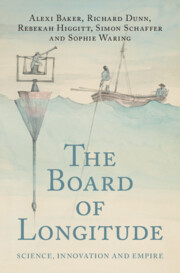Book contents
- The Board of Longitude
- The Board of Longitude
- Copyright page
- Dedication
- Contents
- Figures
- Tables
- Boxes
- Acknowledgements
- Timeline
- Abbreviations
- 1 Introduction
- 2 Sailing the Oceans and Seeking Longitude before 1714
- 3 Launching the Eighteenth-Century Search for Longitude
- 4 The Early Commissioners in Transition
- 5 The Birth of the Board of Longitude
- 6 Time Trials
- 7 Manufacturing the Nautical Almanac
- 8 Managing, Communicating and Judging Longitude after Harrison, 1774–c. 1800
- 9 A Practical Institution Weighed Down by Impractical Proposals?
- 10 What Is an Observatory? From the Metropolis to the Cape
- 11 The Death and Rebirth of the Board of Longitude
- Epilogue
- Book part
- Glossary
- Bibliography
- Index
6 - Time Trials
The Board of Longitude and the Watchmaking Trade, 1770–1821
Published online by Cambridge University Press: 11 April 2025
- The Board of Longitude
- The Board of Longitude
- Copyright page
- Dedication
- Contents
- Figures
- Tables
- Boxes
- Acknowledgements
- Timeline
- Abbreviations
- 1 Introduction
- 2 Sailing the Oceans and Seeking Longitude before 1714
- 3 Launching the Eighteenth-Century Search for Longitude
- 4 The Early Commissioners in Transition
- 5 The Birth of the Board of Longitude
- 6 Time Trials
- 7 Manufacturing the Nautical Almanac
- 8 Managing, Communicating and Judging Longitude after Harrison, 1774–c. 1800
- 9 A Practical Institution Weighed Down by Impractical Proposals?
- 10 What Is an Observatory? From the Metropolis to the Cape
- 11 The Death and Rebirth of the Board of Longitude
- Epilogue
- Book part
- Glossary
- Bibliography
- Index
Summary
This chapter examines the Board of Longitude’s relationships with watchmakers in the five decades after their dealings with John Harrison. In this period in which the chronometer – a term brought into more common use in the period – began to develop into a stable technology, the Board still fielded proposals for schemes about mechanical timekeeping and actively engaged with a small number of makers. Acting within the remit of a new Longitude Act in 1774 that significantly changed the terms for testing and reward, the Board increasingly relied on land trials at the Royal Observatory, Greenwich, alongside a small number of long-distance voyages, which provided an additional arena for testing the nascent technology. During this period, the Board became embroiled in two debates that further shaped its horological dealings and saw its authority contested in Parliament. The first, over the work of Thomas Mudge, saw the Board’s authority undermined. The second, centring on a long and bitter dispute between watchmakers Thomas Earnshaw and John Arnold (and son), finally saw the Board’s authority recognised.
- Type
- Chapter
- Information
- The Board of LongitudeScience, Innovation and Empire, pp. 122 - 156Publisher: Cambridge University PressPrint publication year: 2025

